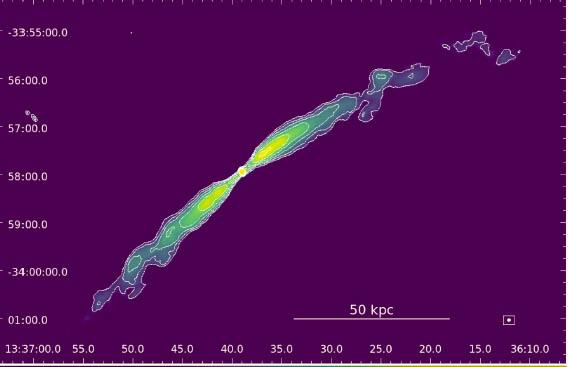
A radio image of the stupendous jets being ejected from around the supermassive black hole at the center of the giant elliptical galaxy IC4293. The scale is indicated ("50 kpc" equals about 165,000 light-years). Astronomers have resolved the puzzle of how, at least in this galaxy, the black hole can continue to be powered by accreting material even though the jets should heat and disburse any potentially infalling gas. They find that the jets deposit most of their energy far beyond the main galaxy.
The oldest known large galactic structures in the universe are giant elliptical galaxies. Unlike our Milky Way and other spiral galaxies, elliptical galaxies have no spiral arms and little or no current star formation activity. Astronomers think that these giants formed in the early universe, less than a billion years after the big bang, after a phase of rapid star-formation. (In contrast, spiral galaxies continue to form stars.) Giant ellipticals evolved to become even larger after this initial phase, but they did so through galaxy mergers and accretion. Those interactions, astronomers think, were dominated by the gravitation of the dark matter that accompanies galaxies.
Giant ellipticals at some point became so large (more than a trillion solar-masses) that the inflowing gas was shock-heated to temperatures above several million Kelvin. The resultant X-ray emitting gas further suppressed the star formation. The same accretion, however, continues to feed their central supermassive black holes, driving the ejection of powerful jets of rapidly moving charged particles that shine brightly at radio frequencies, making these objects early targets of radio telescopes. One of the outstanding puzzlers about these ellipticals is how the hot X-ray emitting gas can stay so hot for so long without cooling down and falling back onto the galaxy to produce new stars. A related question is how the supermassive black holes can continue to grow if material is inhibited from flowing into the center. One hypothesis is that the outflow itself helps to reheat the galaxy and power some circulation.
The giant elliptical galaxy IC4296 is the most massive and centrally located member of a cluster of galaxies called Abell 3565 located about one hundred and fifty million light-years from us. Its radio jets have been known for over thirty years, and extend almost half-a-million light-years into the intergalactic medium. CfA astronomer Paul Nulsen was a member of an international team that combined new radio images from the Karl G. Jansky Very Large Array with archival data from Chandra, XMM-Newton, Hubble, and the Southern Astrophysical Research optical telescope. Their multi-wavelength analysis concludes that this giant elliptical does have dramatic, supersonically expanding jets whose power is comparable to about a hundred billion solar luminosities. They find that the jets appear to not deposit all that energy in the innermost gas of the galaxy, but instead to penetrate into the intercluster medium and heat that gas. Thus the inner material can continue to accrete onto the black hole, thereby resolving the problem of how the supermassive black hole is powered.
"Powerful AGN Jets and Unbalanced Cooling in the Hot Atmosphere of IC 4296," R Grossová, N Werner, K Rajpurohit, F Mernier, K Lakhchaura, K Gabányi, R E A Canning, P Nulsen, F Massaro, M Sun, T. Connor, A. King, S. W. Allen, R. L. S. Frisbie, M. Donahue, and A. C. Fabian, MNRAS 488, 1917, 2019.